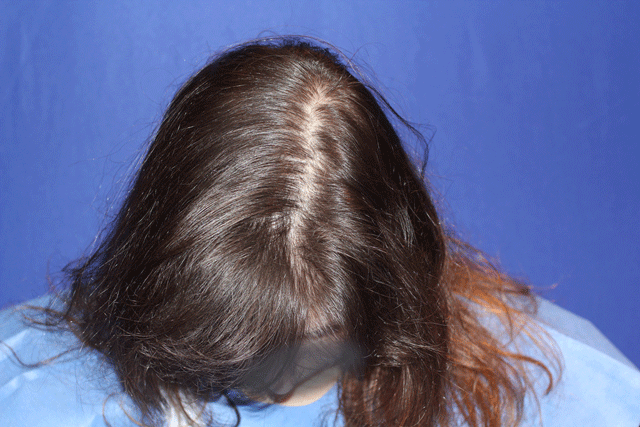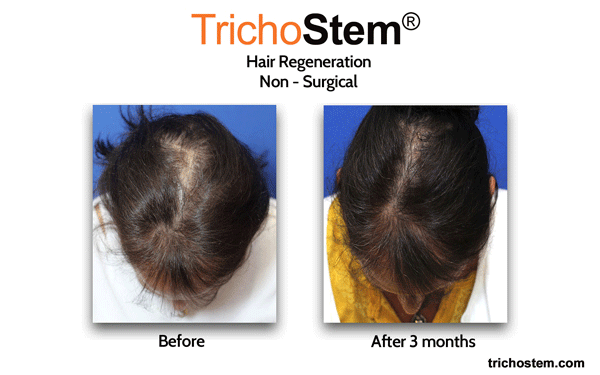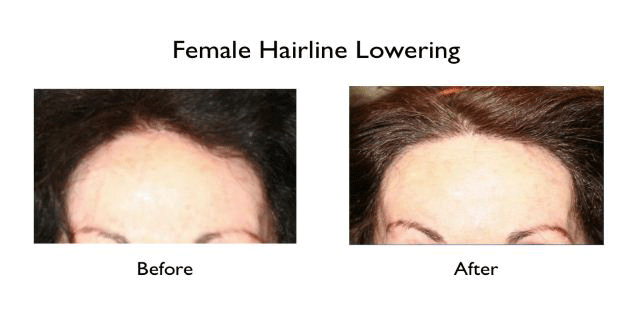Generally it’s well appreciated that women derive much self-esteem and sense of beauty from having good hair.
It’s also well known that when women experience hair loss, it can cause worry, stress anxiety and sometimes depression.
Approximately 30% of women below 50 years of age and around 50% of women above 50 experience hair loss.
What Causes Hair Loss in Women?
Dihyrdotestosterone (DHT) sensitivity or inflammation may be associated with hair loss in women, but science has yet to fully confirm this.
Hair loss in women has a diffused pattern or may occur in different areas of the scalp, so it is not as easily recognizable as hair loss in men. This diffuse thinning or widening of the part, is described as having a “Christmas Tree Pattern”.

Female hair loss is a difficult and often unspoken issue. Female pattern hair loss occurs throughout the head instead of given areas, and can be most identified by a widening of the hair part.
A woman might not even be sure if her hair loss is permanent or temporary due to a condition (for example, pregnancy or illness).
How to Treat Hair Loss in Women?
TrichoStem® Hair Regeneration treatment has shown visible results in 99% of female pattern hair loss patients.

Female pattern hair loss can be treated non-surgically with “TrichoStem® Hair Regeneration”. Over 80% of female patients respond to the treatment, despite the cause of female hair loss being scientifically undetermined.
If you are a woman experiencing hair loss, a consultation with a physician is important to rule out causes from hormonal, nutritional and other skin related conditions before being diagnosed with female pattern hair loss.
Does Hair Transplant Stop Hair Loss?
Hair transplants are generally not an ideal option to treat female pattern hair loss because hair loss occurs throughout the whole head in women. If a hair transplant was performed for female pattern hair loss, the trauma of placing a hair graft could damage the nearby hairs, making the transplant less effective. The only exception where scalp hair transplants are done on women are in cases where scalp hair was lost completely, usually due to injury or traction alopecia (physical stress on the hair causing it to be pulled out).

Female pattern hair loss of the scalp can’t be treated with hair transplantation as placing hair grafts near native hairs will result in collateral damage and loss of native hair. However, in cases where hair is completely lost on the scalp (such as from excessive pulling of hair), or in lowering the hairline, a hair transplant can be performed on women.
Hair transplants are most commonly performed in women where there are no adjacent hairs to damage, such as in hairline lowering transplants in areas of the scalp that are completely devoid of hair. Hair transplants can also be performed in non-scalp areas such as the eyebrows.
What Causes Female Hair Loss?
Alopecia Areata
Alopecia areata is an autoimmune skin disorder in which a person’s own immune system (white blood cells, in particular) attacks hair follicles, mistakenly seeing them as threats to the body. As hair follicles are attacked, they progressively become thin and eventually disappear. Fortunately, the disease is not life-threatening or contagious.
This condition causes patchy hair loss ranging from diffuse thinning to extensive areas of baldness with “islands” of retained hair.
Since changes can occur abruptly, a woman with alopecia areata experiences a drastic change in her appearance, affecting how she sees herself as well as how society views her.
Many of those with one or two small bald patches, recovery is possible in around two years even without treatment.
Triangular Alopecia
Triangular alopecia is a permanent condition wherein hair loss manifests as a triangular bald patch (in some cases, fine, miniature hairs grow) above the temples. The said disorder usually begins at childhood, and sometimes even at birth.
Some studies suggest that the condition may be congenital, but other possible causes have yet to be found.
Fortunately, most of the individuals affected by triangular alopecia are perfectly healthy.
There is currently no medication or lifestyle change that can cure triangular alopecia. However, follicular unit extractions (FUE) and transplantations have proven to be effective solutions.
Scarring Alopecia
Scarring alopecia, also known as cicraticial alopecia, is a disorder wherein inflammation and heat occur at the upper part of the hair follicle where stem cells and oil glands are located. This disorder damages the stem cells and oil glands, resulting in the destruction of hair follicles and eventually, permanent hair loss.
Some may experience severe itching and burning of the scalp before the condition progresses to hair loss.Others, however, don’t feel any pain.
Scarring alopecia patches look “ragged”. Damage occurs underneath the skin surface, so scarring is not usually visible. There are cases though that skin redness and blisters are present.
Two forms of scarring alopecia affect certain groups of women over others.
Central centrifugal cicatricial alopecia affects women of African descent more; while frontal fibrosing alopecia is more common in post-menopausal women (although it also occurs in young women and men).
When scarring alopecia is suspected, a scalp biopsy may be required to determine the presence of scar tissue, inflammation and the possible destruction of hair follicles.
Telogen Effluvium
Telogen effluvium manifests as excessive shedding.
This is a common type of hair loss disorder wherein hair loss is a reaction to hormonal changes, lack of nutrition, drugs, or stress. The reaction results in a decrease in hair-producing hair follicles during the “resting” or telogen phase. In turn, there is an increase in dormant hair follicles and consequently, unusually excessive shedding.
The telogen phase occurs for a duration of 2-4 months. Around 14% of your hair rests at this time, allowing for the replacement of old hair with new ones. Telogen hair strands are those which shed when you shampoo or comb your hair.
Treatment for this condition would depend on the trigger. For example, if stress causes the telogen effluvium, a change in lifestyle might be prescribed.
Loose Anagen Syndrome
Although loose anagen syndrome can be seen in boys, it is more predominant in girls between the ages of 2-6 years. It mostly affects those with blonde to light brown hair.
The disorder is characterized by anagen hairs being easily and painlessly plucked from the scalp.
The anagen phase occurs when hair follicles are actively growing, versus the telogen phase when they are dormant.
With loose anagen syndrome, anagen hair never seems to grow out and strands are noticeably thin, especially at the back. Hair follicles seem, as the syndrome states, “loose”. Although a particular cause is yet to be determined on why the hair is loose, the inner root sheaths (those which anchor hair follicles) of people with loose anagen syndrome were found to be structurally abnormal.
A “pull test” is usually done to determine if an individual has loose anagen syndrome.
Trichotillomania
Rather than a physical illness, trichotillomania is a psychological disorder which involves a compulsion to pull out one’s hair, including hair from the scalp, eyebrows and other parts of the body. Sometimes, individuals with this compulsion even bite, chew, and eat their hair.
Stress or anxiety usually induces hair pulling and acting on the impulse allows the individual to feel relieved and satisfied.
Affecting more women than men, trichotillomania usually develops during adolescence.
Hair pulling results in patchy bald spots, and uneven and broken hair. In turn, these physical signs affect a person’s self-esteem and social and work life.
The said condition is chronic and severity is unpredictable as time progresses.
Before a physical treatment is administered, it is vital that the psychological impulse is addressed first.
Solution for Thinning Hair and Hair Loss
Thinning hair and hair loss can be managed successfully by stimulating hair growth and thickening thinning hair. TrichoStem® Hair Regeneration is the most effective female pattern hair loss solution available, our female pattern hair loss patients have seen increased scalp coverage. View before and after TrichoStem treatment.
If you would like to know more about the treatment and see if its right for you, call our Manhattan, New York City office at (212) 265-8877, or Garden City, Long Island office at (516) 742-4636, Vienna Virginia office at (703) 356-1336, or you can fill up the form below.
